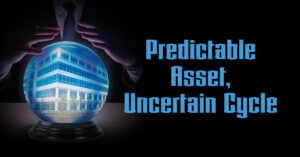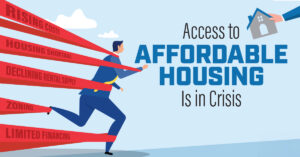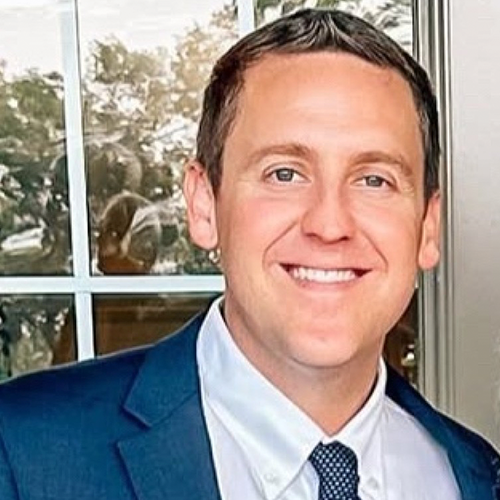For many, 2025 began with a renewed optimism about the commercial real estate market and the economy. And for the most part, the first quarter of this year was living up to those expectations as activity was brisk. But then things took a turn, beginning with President Donald Trump’s self-imposed trade war with U.S. trading partners. The chaotic process of imposing tariffs and then repealing them, sometimes within the same week, rattled financial markets and commercial and residential real estate industries.
Survival mode
Uncertainty became the new watchword, with a troubled economy at home and conflicts abroad. Interest rates have risen, which forced the commercial real estate market to grind almost to a halt. The housing sector also slowed dramatically.
On top of that, legislation was being enacted that would further burden the country with additional debt. With rates on the rise, the increasing debt would inevitably cost taxpayers dearly just to service it.
This was not the outcome most expected for the new year. The mindset during 2024 for mortgage originators had been “survive until ’25.” But as the year progressed, survival became increasingly precarious.
Possible scenarios
So, what will happen during the rest of 2025 and beyond? While no one has a crystal ball, different outcomes for the real estate sector and the overall economy seem plausible.
Both scenarios are based on a number of “what ifs.” One potential outcome for the commercial real estate market would be positive, if inflation continues to decrease (or just remain tame) and the Trump administration secures multiple tariff deals. We could see further rate cuts and the market positioned to rally. Put that with economic growth due to a federal deregulation push, and we could enjoy a strong second half of 2025, with healthy growth into 2026 and beyond.
On the flip side, if trade deals do not end up being finalized and greater tariffs are imposed, it’s hard to see the Federal Reserve lowering interest rates. The resulting tariffs could, in the Fed’s mind, prove to be inflationary. That would keep interest rates higher for longer. That scenario wouldn’t bode well for the commercial real estate market, or the overall economy. Consumers could slow their spending as a result. As this article is being written in mid-June, little has been accomplished concerning rewriting trade deals.
Difficult trade talks
The U.S. reportedly has a trade deal with the U.K. that was signed at June’s G7 summit in Canada. The Trump administration maintains that many other trade deals are being finalized, but negotiations with Canada, the European Union and Japan appear to have stalled, at least for now.
Some of the most important trade talks have been with China, the world’s second-largest economy and leading exporter of goods. On April 10, the Trump administration pushed tariffs on Chinese goods to 145%, according to the Associated Press. In retaliation, Chinese tariffs on U.S. goods reached 125%. Experts reportedly said that those rates would have virtually stopped trade between the two countries.
After a series of negotiations, it was announced in June that U.S. tariffs would be between 30% and 55%, depending on the import. China agreed to impose a 10% tariff on U.S. imports and to sell rare-earth minerals to the U.S. However, these rates are changing as negotiations continue.
Tariff troubles
It seems reasonable to assume that in the future, fewer countries may be willing to make trade deals considering that the Trump administration may be unlawfully using the International Emergency Economic Powers Act (IEEPA) to justify the president’s sweeping powers to impose tariffs. The act requires the U.S. being at war or experiencing another kind of emergency caused by a foreign threat to invoke the extraordinary economic powers in the IEEPA. But it’s not clear who gets to decide whether such a crisis is occurring.
The Trump administration had first declared a national emergency because it claimed the U.S.-Mexico border was being “overrun by cartels, criminal gangs, known terrorists, human traffickers” and smugglers of illicit narcotics. However, the number of people illegally entering the country through the southern border has plummeted in recent months and was at historically low levels in June.
The Trump administration later expanded the emergency to include fentanyl and other drugs coming from China through Canada. But news outlets report that very little of the drug comes from Canada and virtually all of fentanyl makes its way to the U.S. from Mexico.
Another reason for the tariffs has been to bring back manufacturing jobs to the U.S. But that seems increasingly unlikely. We do not need to bring back certain low-paying manufacturing jobs because it would be very difficult to find workers. In addition, bringing back other manufacturing (i.e.- cell phones) will only increase the prices of those products and hurt the consumer, as well as spur inflation. Not a desired outcome for sure.
Debt troubles
One additional unknown is the ability of this administration to cut spending, whether through waste, fraud and abuse or reducing non-discretionary spending. Most experts predict Trump’s so-called “Big, Beautiful Bill” would grow the deficit, causing tumult in the bond market for years to come as we grapple with how to sustain the debt. The experts don’t believe the tax elements of the legislation would promote growth, since they simply make permanent tax cuts already in place. For businesses, the tax plan does little to offset the impacts of tariffs or reduced consumer spending.
“One additional unknown is the ability of this administration to cut spending, whether through focusing on waste, fraud and abuse, or reducing non-discretionary spending.”
Some industry observers are taking a wait and see approach to the economic unknowns that developed in the first half of 2025. The method to their madness could very well be that there is a long game being played that we are unable to see. But this can also prove to be a “Russian Roulette” approach to running an economy that may not be able to regain its footing should the positive outcome not come to fruition. In such a scenario, the commercial real estate market will suffer through yet another year of subdued activity.
Finally, the discussion concerning privatizing the government- sponsored enterprises Fannie Mae and Freddie Mac, which play a crucial role in the financing of the housing industry, could have a negative impact on both the residential and commercial (multifamily) markets. There are worries that a privatization plan could remove the guaranty offered by the U.S. government to backstop the two companies. If that no longer existed, it would be a seismic shift in how both residential and multifamily loans would be priced, underwritten and funded. Such a move would prove counterproductive to the housing and affordability crisis facing the nation today.
It seems reasonable to expect the pricing for Fannie and Freddie would increase, as would costs, if the guaranty is removed. The secondary market would undoubtedly face an upheaval and problems in the housing market would be exacerbated.
As always, it’s best to remain optimistic and we can only play the hand we are dealt. So, preparing for either a positive or negative outcome would prove prudent as the present state of uncertainty may be with us for some time to come.
Author
-

Rob Diodato is the president of York Commercial Finance, a commercial mortgage advisory company with offices in Dallas and New York. Diodato arranges financing for commercial real estate transactions nationwide for all property types. Diodato has more than 26 years of experience in the commercial and residential mortgage industries.
View all posts





















































